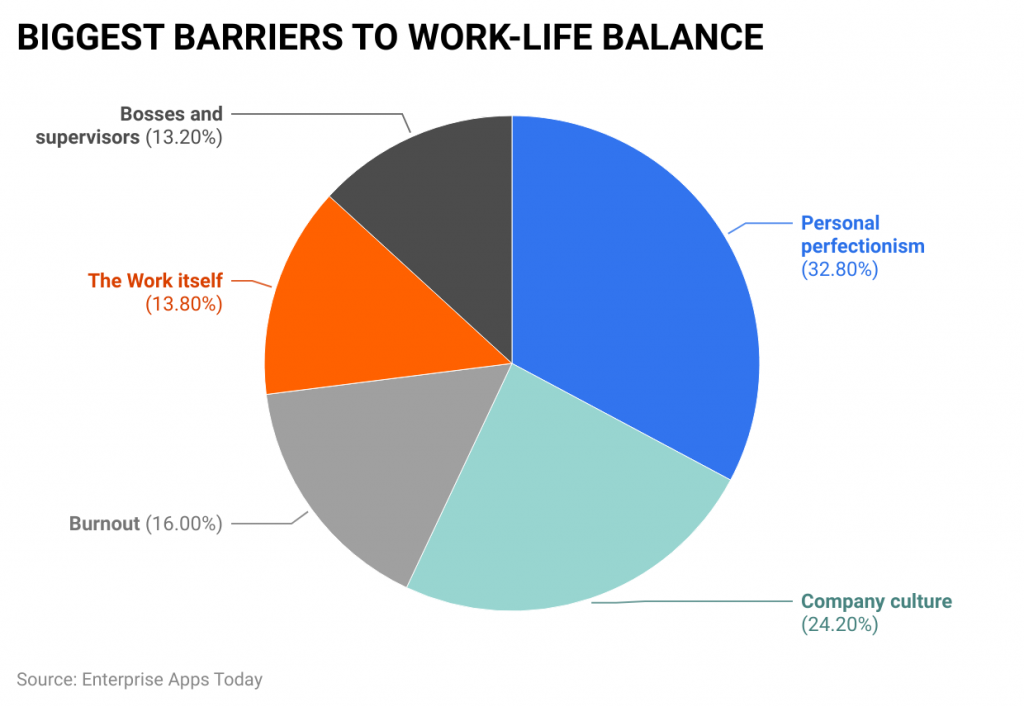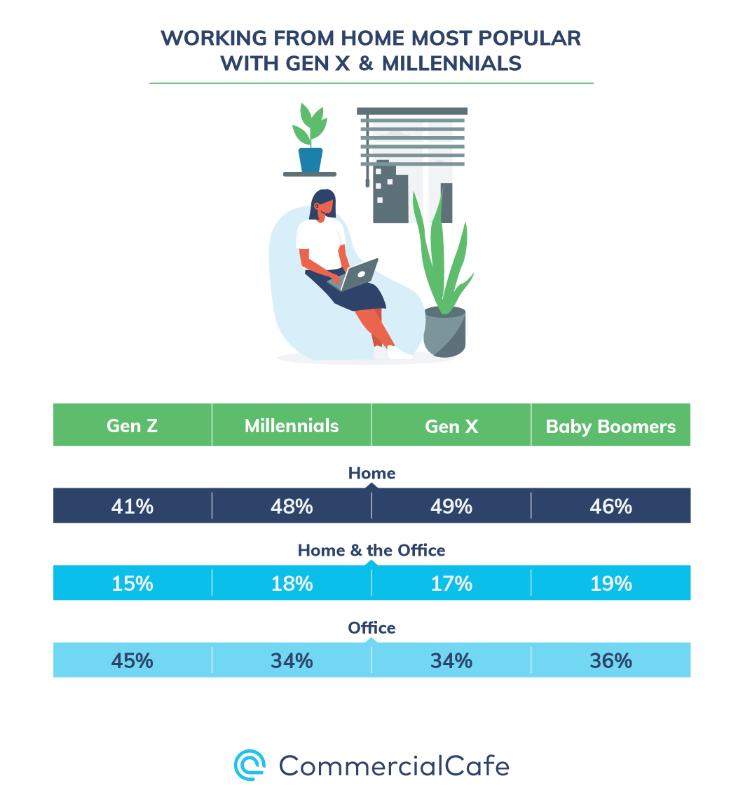(Reference: elitecontentmarketer.com)
by Flexible vs. Non-Flexible Working
Work-life balance: with flexible job option = 54%, without flexible job option = 29%
Stressed by their level of work-life balance: with flexible job option = 21%, without flexible job option = 43%
Percentage of those whose boss’s work habits make work-life balance easy for employees: with flexible job option = 35%, without flexible job option = 14%
Percentage of those whose boss’s work-life balance is difficult for employees: with flexible job option = 27%, without flexible job option = 40%
by Barriers

Personal perfectionism = 32.80%
Company culture disturbance = 24.20%
Burnout = 16%
The work pressure itself = 13.80%
Supervisors and bosses pressure = 13.20%
by Challenges
Lack of support and recognition for employees by the company’s leaders was termed as the biggest burnout of work-life balance which has been agreed by 31% of employees.
Deadlines and unrealistic expectations = 30% of employees
Long hours of working or working on weekends = 29%
Reasons Statistics For Not Having a Work-Life Balance
In the United States, 2022 there are 29% of remote employees and 23% of office workers. The above graph describes the possible reasons for the work-life imbalance between remote and on-site workers.
Experiencing stress during working hours: remote worker = 54%, and on-site workers = 49%
Experiencing anxiety: remote worker = 45%, and on-site workers = 42%
Feeling overwhelmed: remote worker = 26%, and on-site workers = 17%
Having low motivation to work: remote worker = 18%, and on-site workers = 17%
Best Work-life Balance Statistics by Best Country
Over the world in 2022, the best work-life balance was achieved by Italy with a score of 9.4 out of 10, Denmark = 8.6, Norway = 8.5, Spain = 8.3, France = 8.1, Sweden = 8.1, Germany = 8.0, Costa Rica = 1.3, Mexico = 0.4, and Colombia = 0.6
Across the World by Generation
Baby Boomers: Realistic = 77.1%, Neither realistic nor unrealistic = 3.8%, and Unrealistic = 19.1%
Generation X: Realistic = 70.8%, Neither realistic nor unrealistic = 2.8%, and Unrealistic = 26.5%
Millennial: Realistic = 67.5%, Neither realistic nor unrealistic = 5.9%, and Unrealistic = 26.6%
In the U.S. by Generation
In the United States in 2022, work-from-home workers have earned better work-life balance i.e., Gen Z = 41%, Millennials = 48%, Gen X = 49%, and Baby Boomers = 46%
Hybrid workers: Gen Z = 15%, Millennial = 18%, Gen X = 17%, and Baby Boomers = 19%
On-site or office workers: Gen Z = 45%, Millennial = 34%, Gen X = 34%, and Baby Boomers = 36%
Satisfied with their work-life balance: Gen Z = 50%, Millennial = 61%, Gen X = 63%, and Baby Boomers = 77%
Dissatisfied with their work-life balance: Gen Z = 25%, Millennial = 20%, Gen X = 20%, and Baby Boomers = 12%
by Country
The Netherlands experienced the best work-life balance in 2023; employees by only 0.4% worked for long hours.
In 2022, the best countries for work-life balance are Luxembourg, Finland, Norway, Iceland, Netherlands, Sweden, Spain, Austria, Estonia, and Germany.
In Turkey, almost 1/3 of employees work so hard every week that is around 50 hours.
In Colombia, more than 25.5% of employees have worked for more long hours by the end of 2022.
By the end of 2022, employees experienced overworked in South Korea by 25.2%
In Mexico, people spend around 12.4 hours on different leisure activities such as sleeping, and employees by 28.7% have worked long hours, which has imbalanced their work life.
Mexican employees by 27% worked more than 50 hours a week.
Southern Asian regions worked 49 hours per week on average employees.
In 2022, American by 63% have chosen better work-life flexibility rather than salary increments, and 83% claimed remote or hybrid jobs for enhancing their work-life balance.
In the United States, people spend 14.4 hours on leisure activities which is about 60% of the day, whereas around the world people spend almost 25 hours on leisure activities and sleep which is about 67% of the day.
Across the world, 22% of employees haven’t tried any measures to improve their work-life balance.
by Gender Difference
Men (non-parents): Realistic = 74.9%, Neither realistic nor unrealistic = 4.4%, and Unrealistic = 20.7%
Women (non-parents): Realistic = 69.4%, Neither realistic nor unrealistic = 4.7%, and Unrealistic = 25.9%
Men (parents): Realistic = 70.7%, Neither realistic nor unrealistic = 3.1%, and Unrealistic = 26.2%
Women (parents): Realistic = 69%, Neither realistic nor unrealistic = 4.7%, and Unrealistic = 26.4%
Across the world in 2022, male employees by 14% can work for longer time as compared to 6% of women.
According to Statista, 78% of females and 67% of males preferred the work-life balance more important.
By Wealth, Happiness, and Healthiest Among Countries
Least Working Hours Statistics by Countries
Germany = 1349 hours/year
Denmark = 1363 hours/year
Luxembourg = 1382 hours/year
Netherlands = 1417 hours/year
Norway = 1427 hours/year
Iceland = 1433 hours/year
Austria = 1442 hours/year
Sweden = 1444 hours/year
France = 1490 hours/year
Belgium = 1493 hours/year
U.S. Adult’s Statistics by work-life Balance
Work-life balance is an important aspect that has been accepted by 88% of employees.
Over consistent work hours, 88% of employees preferred work-life balance in 2022.
86% of employees preferred work-life balance over easy commute.
In the case of choosing an employer around 57% of people prioritized good and healthy work-life balance.
For improving the work-life balance of employees 83% of American employees preferred working for 4 days a week.
Work-life balance helped in improving 79% mental health, and 78% more productive.
As of 2022, American managers didn’t encourage and motivate employees when they needed the most to take time off agreed to 58% of respondents, whereas 42% of employees said managers have actively encouraged employees.
According to the statistics of PTO, there were no paid-offs available for 31% of U.S. workers.
Conclusion
As of now, after completing the article on Work-Life Balance Statistics, it can be stated that the work-life balance is essential for both companies and employees. This also allows for boosting employee retention by enabling healthy well-being and enhanced productivity across the world and the United States.
Better work-life balance helps reduce employees’ stress, enhance job satisfaction, and along with retaining top talents for companies. As of reports in the U.S. 72% of employees preferred work-life balance against any other factors. Thus, the article includes several other important statistics that will help better understand the topic.
[3px] border-t-[3px] p-4 border-[#1d598f] my-4″ style=”box-shadow: 0 0 14px rgb(9 38 66 / 8%);”>
Sources
How to improve work life balance?
Work life balance can be improved by setting and sticking to clear boundaries that depends on the type of job. Mostly communication with managers or leaders or boss is an important requirement for employees in their need.
What are the causes of poor work life balance?
The main causes of poor work life balance are personal perfectionism, disturbances within different companies culture, burnout factor, work pressure, and supervisors and bosses pressure.
What are the benefits of work life balance?
The work life benefit includes better employee retention and acquisition, allows in increasing employee morale, promotes healthy life, and productivity increment.
Work-Life Balance Statistics By Facts, Importance, Burnout, Flexible vs. Non-Flexible and Barriers
Data is from 2023 and 2024 and forecast data is for 2025 and 2026. We also expand the forecast data to 2027 and 2028.
——
REFERENCES:
This information was taken from various sources around the world, including these countries:
Australia, Canada, USA, UK, UAE, India, Pakistan, Philippines, Indonesia, Nigeria, Tanzania, Kenya, US, United Kingdom, United States of America, Malaysia, U.S., South Africa, New Zealand, Turkey, United Arab Emirates.
Afghanistan, Albania, Algeria, American Samoa, Andorra, Angola, Anguilla, Antarctica, Antigua and Barbuda, Argentina, Armenia, Aruba, Australia, Austria, Azerbaijan.
Bahamas, Bahrain, Bangladesh, Barbados, Belarus, Belgium, Belize, Benin, Bermuda, Bhutan, Bolivia, Bosnia and Herzegovina, Botswana, Bouvet Island, Brazil, British Indian Ocean Territory, Brunei Darussalam, Bulgaria, Burkina Faso, Burundi.
Cambodia, Cameroon, Canada, Cape Verde, Cayman Islands, Central African Republic, Chad, Chile, China, Christmas Island, Cocos (Keeling Islands), Colombia, Comoros, Congo, Cook Islands, Costa Rica, Cote D’Ivoire (Ivory Coast), Croatia (Hrvatska), Cuba, Cyprus, Czech Republic.
Denmark, Djibouti, Dominica, Dominican Republic, East Timor, Ecuador, Egypt, El Salvador, Equatorial Guinea, Eritrea, Estonia, Ethiopia, Falkland Islands (Malvinas), Faroe Islands, Fiji, Finland, France, Metropolitan, French Guiana, French Polynesia, French Southern Territories.
Gabon, Gambia, Georgia, Germany, Ghana, Gibraltar, Greece, Greenland, Grenada, Guadeloupe, Guam, Guatemala, Guinea, Guinea-Bissau, Guyana, Haiti, Heard and McDonald Islands, Honduras, Hong Kong, Hungary, Iceland, India, Indonesia, Iran, Iraq, Ireland, Israel, Italy.
Jamaica, Japan, Jordan, Kazakhstan, Kenya, Kiribati, North Korea, South Korea, Kuwait, Kyrgyzstan, Laos, Latvia, Lebanon, Lesotho, Liberia, Libya, Liechtenstein, Lithuania, Luxembourg.
Macau, Macedonia, Madagascar, Malawi, Malaysia, Maldives, Mali, Malta, Marshall Islands, Martinique, Mauritania, Mauritius, Mayotte, Mexico, Micronesia, Moldova, Monaco, Mongolia, Montserrat, Morocco, Mozambique, Myanmar.
Namibia, Nauru, Nepal, Netherlands, Netherlands Antilles, New Caledonia, New Zealand (NZ), Nicaragua, Niger, Nigeria, Niue, Norfolk Island, Northern Mariana Islands, Norway.
Oman, Pakistan, Palau, Panama, Papua New Guinea, Paraguay, Peru, Philippines, Pitcairn, Poland, Portugal, Puerto Rico, Qatar, Reunion, Romania, Russia, Rwanda, Saint Kitts and Nevis, Saint Lucia, Saint Vincent and The Grenadines, Samoa, San Marino, Sao Tome and Principe.
Saudi Arabia, Senegal, Serbia, Seychelles, Sierra Leone, Singapore, Slovakia, Slovenia, Solomon Islands, Somalia, South Africa, South Georgia and South Sandwich Islands, Spain, Sri Lanka, St. Helena, St. Pierre and Miquelon, Sudan, Suriname, Svalbard and Jan Mayen Islands, Swaziland, Sweden, Switzerland, Syria.
Taiwan, Tajikistan, Tanzania, Thailand, Togo, Tokelau, Tonga, Trinidad and Tobago, Tunisia, Turkey, Turkmenistan, Turks and Caicos Islands, Tuvalu, Uganda, Ukraine, United Arab Emirates (UAE), UK (United Kingdom), USA (United States of America, U.S.), US Minor Outlying Islands.
Uruguay, Uzbekistan, Vanuatu, Vatican City State (Holy See), Venezuela, Vietnam, Virgin Islands (British), Virgin Islands (US), Wallis and Futuna Islands, Western Sahara, Yemen, Yugoslavia, Zaire, Zambia, Zimbabwe.
Work-Life Balance Statistics By Facts, Importance, Burnout, Flexible vs. Non-Flexible and Barriers
August 13, 2024
Source link : http://www.bing.com/news/apiclick.aspx?ref=FexRss&aid=&tid=66c2a6f0b1204d509bc7e96606e1de44&url=https%3A%2F%2Fhollywoodgazette.com%2Fwork-life-balance-statistics-html%2F&c=8482451139022288905&mkt=en-us
Author :
Publish date : 2024-08-18 14:26:00
Copyright for syndicated content belongs to the linked Source.
